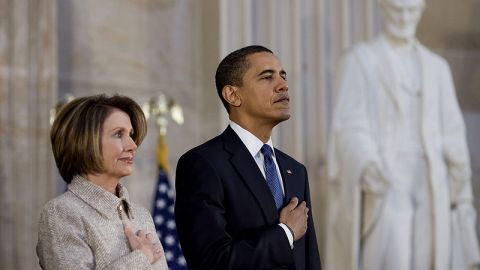The Health Care Fight Will Come Down to the Wire

It’s not clear if the Democrats have the votes to get health care reform through Congress. Earlier versions of the bill have already passed both the House and the Senate—and, in the Senate’s case, passed with a supermajority of 60 votes. Because the Democrats can use the reconciliation process, which allows them to avoid the threat of filibuster as long as they only amend budget-related provisions of the bill, they should be be able to pass a version of the bill both the House and Senate can agree on with just a simple majority in the Senate. But even though they actually need fewer votes to pass the final version of the bill, it’s going to be tough to do.
That’s in large part because Scott Brown (R-MA) managed to win the special election for the late Ted Kennedy’s old Senate seat by campaigning against health care reform. That’s a bit of an irony, since Massachusetts’ popular health care system is actually more liberal than the proposal before Congress—and even includes a government-run health plan. But Massachusetts voters nevertheless voted for Brown in part because of their dissatisfaction with the health care reform process in Congress. With the 2010 elections approaching, many Democrats who originally voted yes have begun to fear that passing health care reform could cost them their own seats—even though, of course, if they do vote against the final bill they will be attacked both for having voted for the bill originally and for flip-flopping.
Republicans, meanwhile, are attacking the Democrats for using the reconciliation process to revise the bill, saying that the Democrats are using a procedural trick to force the health care bill through Congress. In fact, most of the bill has already passed both houses of Congress, and any provisions that are altered using the reconciliation process would still require a majority vote to pass. The only reason the Democrats have to resort to reconciliation in the first place is to stop the Republicans from using another procedural trick—the filibuster—to block a vote on the bill with a minority of just 41 senators. Although it has now been around for a while, as Ezra Klein points out, far from being a part of the Constitutional design of the Senate, the filibuster is actually a byproduct of Senate rules created for other reasons. And reconciliation has been used many times since it was created in 1974 to get around the filibuster—including 16 times by Republican-controlled Senates. It has even been used for major legislation, including welfare reform in 1996 and the enormous Bush tax cuts in 2001 and 2003. Nevertheless, the Republican attacks have made some Democrats nervous that voters will see them as contributing to the ugly partisanship of this Congress.
The original bill passed the House by just five votes. With the death of Jack Murtha (D-PA) and the retirements of Neil Abercrombie (D-HI) and Robert Wexler (D-FL), the Democrats have lost three of their original yes votes. There may be more yes votes out there, because some of the representatives who originally voted no might have been persuaded to vote yes if their vote had actually been needed to pass the bill. But the margin for error is clearly small. And a group of 12 Democrats lead by Rep. Bart Stupak (D-MI) say they’ll vote against any bill that doesn’t include an amendment preventing any federal funds from being used to pay for elective abortions. As First Read notes, the bill already forbids federal funds to pay for elective abortions—never mind that the Hyde Amendment attached to every budget bill already forbids federal money be used that way. And, as my fellow Big Think blogger Lindsay Beyerstein points out, the health care bill only funds abortions in the sense that people who benefit from government subsidies might use their own money to pay for abortions. And by that rationale essentially all government programs already subsidize abortions by helping people who might choose to have them. Nevertheless, the abortion issue provides Democrats a plausible-seeming excuse for voting no, as well as a justification for demanding concessions.
So the battle is on. The Republican Party has begun putting up billboards in the districts of House Democrats who haven’t yet decided how to vote. The U.S. Chamber of Commerce and some insurance industry groups are airing an ad accusing Congress of using “special rules” to ram through a bill and impose billions of dollars of new taxes. The Democratic National Committee is countering with an ad attacking the insurance industry for raising premiums—as it recently has in California—and the Republicans for backing the insurance companies. Senate Majority Leader Harry Reid (D-NV) sent an angry open letter to Minority Leader Mitch McConnell (R-KY), accusing the Republicans of bad faith and obstructionism. And Democrats can point out that the Congressional Budget Office now estimates that the latest version of the bill would reduce the deficit by $118 billion by 2019. Right now Intrade, the political futures market, gives the bill a 55% chance of passing. Speaker of the House Nancy Pelosi (D-CA) told Charlie Rose this week that if the vote were taken now the bill would pass—but that could easily change before the bill comes to a vote.





